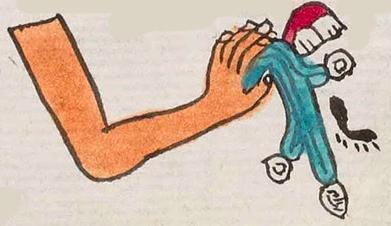Alahuiztlan (Mdz37r)
This compound glyph for the place name Alahuiztlan has a few components, an arm with a hand, from which water (atl or ātl) flows downward (a direction provided by the downward facing black footprint), and a pair of teeth (tlantli, providing the locative suffix -tlan). The arm is a left arm, with the left hand extending toward the viewer's right. The teeth involve two white, front, upper teeth with a red gum. The water is a typical turquoise blue with lines indicating current or flow and droplets/beads or turbinate shells at the tips or splashing off the flow.
Stephanie Wood
Frances Karttunen interprets the key graphic elements as water [ā-] and a downward direction [alāhua]. These graphics give phonetic clues to the relevant morpheme: alāhuiz- (slipperiness, from alāhua, "to slip, slide"). Matthew T. McDavitt (J.D.) suggests an unattested noun, alahuiztli, which would mean "landslide," and the place name would then be next to or "Below the Landslide." He sees the arm as pushing and the footprint as "temoc" (to descend) resulting in the arm ideographically pushing down (the land). [Personal communication, 12/28/2022.]
The beginning of the place name, "Ala," is also tempting to read as a Spanish loanword for "to the." This would combine well with "south" (despite the slight variation between huitztlan and huiztlan). We do have attestations of the incorporation of "ala" in loans that entered Nahuatl from Spanish, such as "alahuerta," for orchard or kitchen gardens, with the motion incorporated into the noun but only implied.
What is actually pictured for this glyph might suggest, alternatively, a reading of Amatlan ("a" from atl), water, "ma" from maitl), hand or arm, and "-tlan" the locative suffix, whose phonetic representation comes from tlantli), teeth. We do have other glyphs indicating Amatlan, however, and these much more efficiently use the glyph for paper, amatl). Finally, a reading of Amatlan would leave out the footprint element.
Footprint glyphs have a wide range of translations. In this collection, so far, we can attest to yauh, xo, pano, -pan, paina, temo, nemi, quetza, otli, iyaquic hualiloti, huallauh, tetepotztoca, totoco, -tihui, and the vowel "o." Other research (Herrera et al, 2005, 64) points to additional terms, including: choloa, tlaloa, totoyoa, eco, aci, quiza, maxalihui, centlacxitl, and xocpalli.
Stephanie Wood
alahuiztlā puo
Alahuiztlan, pueblo (or Allahuiztlan? Alahuitztlan?)
Stephanie Wood
c. 1541, or by 1553 at the latest
Stephanie Wood
arms, elbows, hands, water, teeth, footprint, feet, shells, brazos, codos, manos, agua, dientes, huellas de pie, icximachiyotl, xocpalli, icxipamitl, pies, caracoles, nombres de lugares

a(tl), water, https://nahuatl.wired-humanities.org/content/atl
alahua or alāhua, to slip, https://nahuatl.wired-humanities.org/content/alahua
huitztlan, south, https://nahuatl.wired-humanities.org/content/huitztlan
mai(tl), hand or arm, https://nahuatl.wired-humanities.org/content/matl
-pan, on, https://nahuatl.wired-humanities.org/content/pan
-tlan (locative suffix), place, https://nahuatl.wired-humanities.org/content/tlan
"Slippery Place" [Frances Karttunen, unpublished manuscript, used here with her permission.]
"Cerca del Corrimiento o Desprendimiento de Tierras"
Stephanie Wood (drawing from the suggestion of Matthew T. McDavitt)
Codex Mendoza, folio 37 recto, https://digital.bodleian.ox.ac.uk/objects/2fea788e-2aa2-4f08-b6d9-648c00..., image 84 of 188.
The Bodleian Libraries, University of Oxford, hold the original manuscript, the MS. Arch. Selden. A. 1. This image is published here under the UK Creative Commons, “Attribution-NonCommercial-ShareAlike 3.0 License” (CC-BY-NC-SA 3.0).



